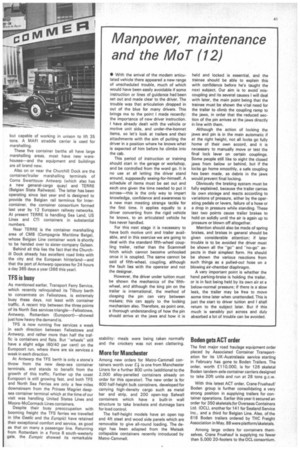Manpower, maintenance and the MoT (12)
Page 43

If you've noticed an error in this article please click here to report it so we can fix it.
• With the arrival of the modem articulated vehicle there appeared a new range of unscheduled trouble, much of which would have been easily avoidable if some instruction or lines of guidance had been set out and made clear to the driver. The trouble was that articulation dropped in out of the blue for many drivers. This brings me to the point I made recently: the importance of new driver instruction. I have already dealt with the vehicle or motive unit side, and under-the-bonnet items, so let's look at trailers and their attachments with the aim of putting the driver in a position where he knows what is expected of him before he climbs into the cab.
This period of instruction or training should start in the garage or workshop, and be controlled from the word go. It is no use at all letting the driver stand around, supposedly seeing-for-himself. A schedule of items must be set out and each one given the time needed to put it across—this is the only way to impart knowledge, confidence and awareness to a new man meeting strange tackle for the first time. It applies equally to a driver converting from the rigid vehicle he knows, to an articulated vehicle he has never handled.
For this next stage it is necessary to have both motive unit and trailer available, and in this exercise we are going to deal with the standard fifth-wheel coupling trailer, rather than the Scammell hitch which cannot become unhooked once it is coupled. The same cannot be said of fifth-wheel, coupling, although the fault lies with the operator and not the designer.
However, the driver under tuition must be shown the mechanics of the fifthwheel, and although the king pin on the trailer is international, the method of clasping the pin can vary between makers; this can apply to the locking mechanism also. Therefore, as point one, a thorough understanding of how the pin should arrive at the jaws and how it is held and locked is essential, and the trainee should be able to explain this with confidence before he's taught the next subject. Our aim is to avoid miscoupling and its several causes I will deal with later, the main point being that the trainee must be shown the vital need for the trailer to climb the coupling ramp to the jaws, in order that the reduced section of the pin arrives at the jaws directly in line with them.
Although the action of locking the jaws and pin is in the main automatic if at the right height, not all locks go fully home of their own accord, and it is necessary to manually move or test the final lock lever on certain couplings. Some people still like to sight the closed jaws from below or behind, but if the locks go home smoothly, a safe coupling has been made, as debris in the jaws would prevent final locking.
Obviously the braking system must be fully explained, because the trailer carries its own storage and reacts according to variations of pressure, either by the operating pedals or levers, failure of a hose or a drop in pressure while standing. These last two points cause trailer brakes to hold on solidly until the air is again up to pressure or blown off altogether.
Mention should also be made of spring brakes, and brakes in general should be given considerable attention; if later trouble is to be avoided the driver must be shown all the "go" and "no-go" aspects in their simplest form. He should be shown the various reactions from such things as a pulled-out hose on a blowing air-chamber diaphragm.
A very important point is whether the hand parking-brake is holding the trailer, or is in fact being held by its own air at a below-normal pressure; if there is a slow leak, the trailer may be free to move some time later when unattended. This is just the start to driver tuition and I shall return to the subject later. But if this much is sensibly put across and duly absorbed a lot of trouble can be avoided.












































































































